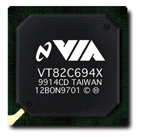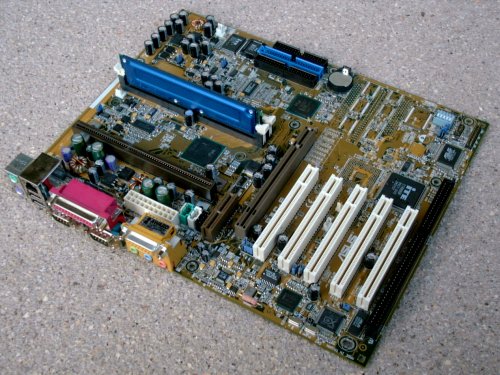Performance Showdown at 133 MHz FSB - The best Platform for Coppermine
Introduction
Who wouldn't remember October last year, when Intel released its successor of the Pentium III with the 'Katmai' core. The introduction of the new Pentium III with the 'Coppermine' core was essential for Intel, because this new processor was Intel's only weapon against AMD's new Athlon processor, the clear performance leader at that time. Athlon had been so much faster and even cheaper than 'Katmai', that Intel had been starting to lose face. 'Coppermine' a processor core based on 'Katmai's' core, but improved with full speed and on-die 2nd level cache that was connected to the computing units with a data path 4 times as wide as Katmai's, turned out to be significantly faster than its predecessor at the same clock speed and it could at least catch up with Athlon, although not quite overtake it. From that point of view everything should have been fine for Intel. However, a wrong decision from the past had caught up with mighty Chipzilla. Rambus started to wreck havoc with Intel's future platform plans.
Has The Force Left Intel?
One of the new features of 'Coppermine' was its support for 133 MHz front side bus speed. Higher FSB's are always welcome and so everybody should have been happy with it, if, yes, if there had been an Intel platform to support it. The Force hadn't really been with Intel last year, which is something that I appreciate, since the dark side of the Force had hit me in April 1999 as well. I had been badly betrayed by the greed of some so-called 'friends', but Intel had been betrayed by its own greed, which makes the story a bit more enjoyable. Quite a while back Intel had decided that Rambus is the memory of the future. The reason behind this decision was not necessarily the superiority of the Rambus-design, but the fact that Intel could buy a significant amount of shares of the sweet little company back then, planning to finally rule the memory market, once it had taught the world that there was only one way in the IT-business and that was Intel's way.
Intel's 'Caminogate' I820
Intel's new chipset, that was supposed to support the 'Coppermine'-processor, was first known under the code name 'Camino'. It was supposed to be the first PC-chipset to support Rambus or RDRAM. RDRAM was and still is not exactly popular in the industry, because Rambus Inc. owns the design and so each memory maker producing RDRAM has to pay royalties to Rambus Inc. Intel didn't bother about that, since history had proven that whatever Intel proclaimed as the future direction was finally accepted by the world. Unfortunately however, the Force had left the designers of Camino. The effect was rather devastating. 'Camino', today known as 'Intel 820 ' chipset, turned out to have a major bug in the very last minute before its planned release. This had been relayed to the poor motherboard makers so late, that some of them couldn't even stop their marketing campaigns for i820 anymore. Intel also decided against any further delay of 'Coppermine', so that this new processor was released without an Intel-platform for it. What happened after that is history and known to all of us. Finally i820 was released, but castrated to only 2 RIMM slots for the super expensive RDRAM. The Intel820 chipset may perform well, but nobody can afford RDRAM. Thus people considered Intel's half-baked 'MTH'-solution that supports PC100 SDRAM. It translates the parallel CPU protocol in the serial RDRAM protocol and then back into the parallel SDRAM protocol, which results in mediocre performance. The next thing that came as a shock was when Intel admitted that i820 plus SDRAM is having problems as well. ECC SDRAM leads to crashes, which is as paradox as it comes, but who would wonder about that anymore? We've learned to expect the craziest stuff from Intel today.
VIA's Apollo Pro 133A, VT82C694X
VIA, who made it into the league of Intel's arch enemies recently, had come out with a chipset that offered 133 MHz FSB (inofficially!) and PC133 SDRAM support already in June 1999. By that time the performance of the Apollo Pro Plus (VT82C693) platforms was rather mediocre though. Then VIA saw its big chance when 'Caminogate' (copyright Mike Magee, The Register ) took place. At the time of the Coppermine-launch VIA's Apollo Pro 133 (VT82C693A) was the only performance chipset that supported the 133 MHz FSB and thus the 'real' Coppermine. Nobody was crazy enough to plug this expensive new and fast Intel processor into an i810e-platform, although i810e was at least able to support 133 MHz FSB. The integrated 3D-deccelerator and only PC100 SDRAM support hinder its performance and make it rather unattractive. Anyway, VIA's new Apollo Pro 133A (VT82C694X) chipset now offers full Coppermine support, AGP4x, PC133 SDRAM support instead of the super expensive RDRAM and it comes without any major bugs. Therefore it is the born competitor against Intel's cursed i820 chipset. It took a long while though, until VIA moved from Apollo Pro Plus over Apollo Pro 133 to Apollo Pro 133A. The latter (VT82C694X) finally performs well enough to be considered a performance threat to i820, as Asus' new P3V4X-platform with this new chipset is able to prove impressively.
Quick Comparison
| ChipsetMemory | Intel 820PC 800 RDRAM | Intel 820PC 100 SDRAM | VIA Apollo Pro 133APC 133 SDRAM |
|---|---|---|---|
| AGP | 4X | 4X | 4X |
| ATA interface | UDMA 66 | UDAM 66 | UDMA 66 |
| USB-Hubs | 1 | 1 | 2 |
| Supported Slots/Sockets | Slot1, FC-PGA370 | Slot1, FC-PGA370 | Slot1, FC-PGA370, Socket370 |
| Pricing Motherboard | medium to high | medium to high | low |
| Pricing Memory | very high | low | low |
It's pretty obvious that motherboards with VIA's Apollo Pro 133A (VT82C694) chipset are clearly the cheapest solution for Coppermine. If the performance is right, VIA's Coppermine-solution is the clear winner in this competition.
The Good, The Bad And The Ugly - Who Will Get The Coffin Full Of Gold?
To make the story easy and enjoyable, each representative comes from the same motherboard maker. I chose Asus because I always get their products on time, even early products work reliably and I get the best support. Curtain up, let's have a look at our contestants!
Get Tom's Hardware's best news and in-depth reviews, straight to your inbox.
The Good
You know how things are, 'The Good' could not possibly have been one of the Intel representatives, it's the representative from VIA, the Asus P3V4X with Apollo Pro 133A chipset. The motherboard looks as solid as it actually is, it sports 6 PCI slots, one ISA for the oldies, one AGP, four DIMM slots, two USB-hubs and thus four USB-ports and the Asus 'JumperFree' hardware setup, which can also be disabled, so that the adjustments can be made via dip switches.
The Bad
The P3C-L with RDRAM is playing 'The Bad' in this contest. Why? Well, it's using the bad bad i820 chipset AND the bad bad bad expensive RDRAM on top of it. The Bad is equipped with 5 PCI-slots, one ISA, one AGP, one AMR, it sports onboard LAN with Intel's i82559 and the two RIMM-slots that Intel allows.



